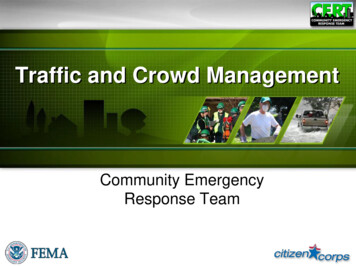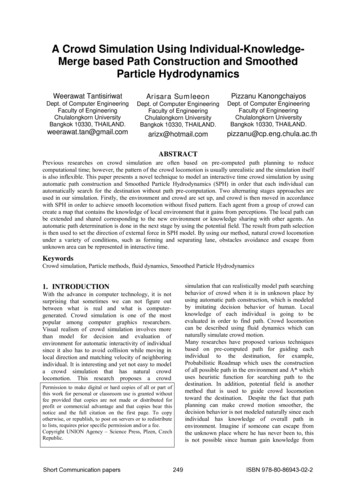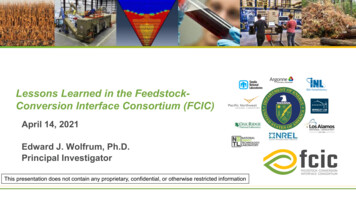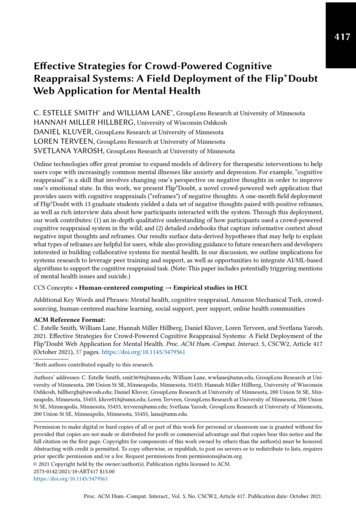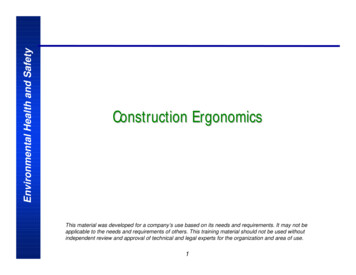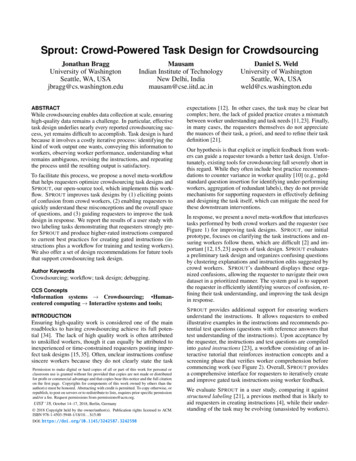
Transcription
Sprout: Crowd-Powered Task Design for CrowdsourcingJonathan BraggUniversity of WashingtonSeattle, WA, USAjbragg@cs.washington.eduMausamIndian Institute of TechnologyNew Delhi, Indiamausam@cse.iitd.ac.inABSTRACTWhile crowdsourcing enables data collection at scale, ensuringhigh-quality data remains a challenge. In particular, effectivetask design underlies nearly every reported crowdsourcing success, yet remains difficult to accomplish. Task design is hardbecause it involves a costly iterative process: identifying thekind of work output one wants, conveying this information toworkers, observing worker performance, understanding whatremains ambiguous, revising the instructions, and repeatingthe process until the resulting output is satisfactory.To facilitate this process, we propose a novel meta-workflowthat helps requesters optimize crowdsourcing task designs andS PROUT, our open-source tool, which implements this workflow. S PROUT improves task designs by (1) eliciting pointsof confusion from crowd workers, (2) enabling requesters toquickly understand these misconceptions and the overall spaceof questions, and (3) guiding requesters to improve the taskdesign in response. We report the results of a user study withtwo labeling tasks demonstrating that requesters strongly prefer S PROUT and produce higher-rated instructions comparedto current best practices for creating gated instructions (instructions plus a workflow for training and testing workers).We also offer a set of design recommendations for future toolsthat support crowdsourcing task design.Author KeywordsCrowdsourcing; workflow; task design; debugging.CCS Concepts Information systems Crowdsourcing; Humancentered computing Interactive systems and tools;INTRODUCTIONEnsuring high-quality work is considered one of the mainroadblocks to having crowdsourcing achieve its full potential [34]. The lack of high quality work is often attributedto unskilled workers, though it can equally be attributed toinexperienced or time-constrained requesters posting imperfect task designs [15, 35]. Often, unclear instructions confusesincere workers because they do not clearly state the taskPermission to make digital or hard copies of all or part of this work for personal orclassroom use is granted without fee provided that copies are not made or distributedfor profit or commercial advantage and that copies bear this notice and the full citationon the first page. Copyrights for components of this work owned by others than theauthor(s) must be honored. Abstracting with credit is permitted. To copy otherwise, orrepublish, to post on servers or to redistribute to lists, requires prior specific permissionand/or a fee. Request permissions from permissions@acm.org.UIST ’18, October 14–17, 2018, Berlin, Germany 2018 Copyright held by the owner/author(s). Publication rights licensed to ACM.ISBN 978-1-4503-5948-1/18/10. . . 15.00DOI: https://doi.org/10.1145/3242587.3242598Daniel S. WeldUniversity of WashingtonSeattle, WA, USAweld@cs.washington.eduexpectations [12]. In other cases, the task may be clear butcomplex; here, the lack of guided practice creates a mismatchbetween worker understanding and task needs [11,23]. Finally,in many cases, the requesters themselves do not appreciatethe nuances of their task, a priori, and need to refine their taskdefinition [21].Our hypothesis is that explicit or implicit feedback from workers can guide a requester towards a better task design. Unfortunately, existing tools for crowdsourcing fall severely short inthis regard. While they often include best practice recommendations to counter variance in worker quality [10] (e.g., goldstandard question insertion for identifying under-performingworkers, aggregation of redundant labels), they do not providemechanisms for supporting requesters in effectively definingand designing the task itself, which can mitigate the need forthese downstream interventions.In response, we present a novel meta-workflow that interleavestasks performed by both crowd workers and the requester (seeFigure 1) for improving task designs. S PROUT, our initialprototype, focuses on clarifying the task instructions and ensuring workers follow them, which are difficult [2] and important [12, 15, 23] aspects of task design. S PROUT evaluatesa preliminary task design and organizes confusing questionsby clustering explanations and instruction edits suggested bycrowd workers. S PROUT’s dashboard displays these organized confusions, allowing the requester to navigate their owndataset in a prioritized manner. The system goal is to supportthe requester in efficiently identifying sources of confusion, refining their task understanding, and improving the task designin response.S PROUT provides additional support for ensuring workersunderstand the instructions. It allows requesters to embedillustrative examples in the instructions and recommends potential test questions (questions with reference answers thattest understanding of the instructions). Upon acceptance bythe requester, the instructions and test questions are compiledinto gated instructions [23], a workflow consisting of an interactive tutorial that reinforces instruction concepts and ascreening phase that verifies worker comprehension beforecommencing work (see Figure 2). Overall, S PROUT providesa comprehensive interface for requesters to iteratively createand improve gated task instructions using worker feedback.We evaluate S PROUT in a user study, comparing it againststructured labeling [21], a previous method that is likely toaid requesters in creating instructions [4], while their understanding of the task may be evolving (unassisted by workers).
Meta WorkersRequester providesinitial erDiagnoseWorkers answerquestions using thecurrent workflowSelect confusing &low-agreementquestionsWorkers diagnosepossibly unclearquestionsWorkers suggestchanges to theinstructionsGenTestWorkers createtest questionswith r itemsand computeitem similaritiesRequester clarifiesthe instructions &test questionsFigure 1. S PROUT is our implemented task-improvement meta-workflow (workflow for improving a task workflow), that interleaves steps where workersanswer questions using the base workflow (blue box) and meta steps (orange boxes), where meta-workers diagnose problems and suggest fixes, whileS PROUT guides the requester to iteratively improve the instructions, add clarifying examples, and insert test questions to ensure understanding.Requesters who participated in our study created gated instructions for two different types of labeling tasks—the mostcommon crowdsourcing task type [15]—strongly preferredand produced higher-rated instructions using S PROUT.tools that help requesters (3) understand user behavior and (4)improve their task design.In summary, this paper makes four main contributions:There is a small but growing body of work elucidating bestpractices for task design. CrowdFlower, a major crowdsourcing platform, reinforces that tasks should be divided into discrete steps governed by objective rules; they also highlight theimportance of clear instructions [9] and test questions [10].Several studies of worker attitudes also point to task clarityproblems as a major risk factor for workers [12, 25, 35]. Furthermore, large-scale analyses have found positive correlationsbetween task clarity features like the presence of examplesand task performance metrics like inter-annotator agreementand fast task completion times [15]. Other controlled empirical studies provide further evidence that examples improvetask outcomes [35]. Some work has sought to systematicallyunderstand the relative importance of various task design features [1, 35], but this work is limited to specific task types andgeneral design principles remain poorly understood. A novel meta-workflow—combining the efforts of bothcrowd workers and the requester—that helps the requestercreate high-quality crowdsourcing tasks more quickly andwith substantially less effort than existing methods. S PROUT, an open-source tool that implements this workflowfor labeling tasks, the most common crowdsourcing tasktype [15]. S PROUT first has workers suggest changes to thetask instructions. It then clusters the suggestions and provides the requester with a comprehensive task-improvementinterface that visualizes the clusters for fast task explorationand semi-automates the creation of a gated instruction (training and testing) workflow by suggesting test questions related to the instructions the requester has written. A user study with requesters with varying amounts ofcrowdsourcing experience comparing S PROUT and structured labeling on two different types of labeling tasks. Theresults demonstrate an overall preference for S PROUT overstructured labeling and for the use of worker feedback during task design. Furthermore, requesters using S PROUTproduced instructions that were rated higher by experts. A set of design principles for future task authoring anddebugging tools, informed by our experience buildingS PROUT, and our observations and discussion with requesters during the user study.We implement the S PROUT tool as a web application andrelease the source code for both it and for structured labelingin order to facilitate future research.1PREVIOUS WORKWe first discuss (1) previous work that characterizes good taskdesign and (2) gated instructions; then, we describe existing1 lDesign Principles for Tasks and WorkflowsEmerging understanding of good workflow design suggeststhat investing in worker understanding is critically important tocrowdsourcing outcomes. A large-scale controlled study compared the efficacy of different quality control strategies, concluding that training and screening workers effectively is moreimportant than other workflow interventions [27]. Providingfeedback about a worker’s mistakes has also been shown to bevery helpful in improving their answer quality [11].These studies demonstrate the strong need for tools likeS PROUT to help requesters clarify the task, include illustrativeexamples, provide training with feedback, and screen workers.Gated InstructionsThe importance of instructions, training, and screening wasalso demonstrated by an analysis of several attempts to crowdsource training data for information extraction [23]. S PROUTadopts gated instruction from this work (see Figure 2). Gatedinstructions is a quality control method that uses test questionsto ensure that workers have read and understood the instructions. It differs from the common practice of mixing 10–30%
inTaskFigure 2. S PROUT runs a gated instruction workflow [23] in the Workstep of the meta-workflow (Figure 1), which ensures workers understandthe instructions before starting the main task. Workers who do not passgating do not continue with the task (indicated by the terminal square).The Refine step of the meta-workflow updates all parts of this workflow(before the first Refine step, only the main task is run since the systemcannot yet construct tutorial or gating questions).gold standard questions into a work stream in the hope of detecting spammers [3,28], since the former is intended to ensureunderstanding not diligence. It also has advantages over otherapproaches like instructional manipulation checks [29], whichtest attentiveness, not understanding; can be gamed [14]; anddo not provide training. A gated instruction workflow insertstwo phases before the main task: an interactive tutorial, followed by a screening phase consisting of a set of questionsworkers must pass in order to start work on the actual task.Understanding Task Ambiguities and Worker BehaviorSeveral tools support understanding of task behaviors. CrowdScape provides visualizations to help requesters understandindividual worker behaviors and outputs [31]. Noting that experimenting on different versions of task instructions, rewards,and flows is time-intensive, CrowdWeaver provides a graphical tool to help manage the process and track progress [20].Cheng et al. [5] propose methods for automatically determining task difficulty. Kairam and Heer [17] provide methods forclustering workers (rather than questions, as S PROUT does).While there has been more emphasis on understanding workerbehaviors, Papoutsaki et al. [30] instead study behaviors ofnovice requesters designing workflows for a data collectiontask; they distill several helpful lessons for requesters.Other tools focus on dataset clustering and understanding.Structured labeling [21] is a tool that produces a clustereddataset with each cluster labeled by a single person akin to therequester. These “structured labels” are a flexible data asset(e.g., can support efficient data relabeling), but are expensiveto produce. Revolt [4] outputs structured labels created by thecrowd (to save requester effort). While structured labels areflexible, it is prohibitively expensive to run Revolt on largedatasets because Revolt asks workers to explain and categorize every unresolved data item. Since Revolt’s goal is nottask improvement, it does not provide a user interface for therequester nor help the requester create good instructions; theirevaluation used simulated requesters. In contrast, S PROUTuses the crowd to help requesters create unambiguous instructions (thereby improving task quality) by examining a larger,more diverse subset of the data than previously possible.Tools for Task and Workflow DesignS PROUT extends a line of research on tools that support designing and debugging workflows. We are inspired by Turkomatic [22], which proposed having workers themselves decompose and define a workflow to solve a high-level taskdescription provided by a requester. Both systems embodya meta-workflow with crowd workers acting in parallel withthe requester. While Turkomatic was only “partially successful” [22], the vision is impressive, and we see S PROUT as diving deeper into the task specification aspect of the greater workflow design challenge. S PROUT also leverages the reusabilityof instructions across many instances of a task, while Turkomatic considered one-off tasks where reusability is limited.Fantasktic [13] was another system designed to help novicerequesters be more systematic in their task instruction creationvia a wizard interface, but did not incorporate worker feedback or aid requesters in identifying edge cases like S PROUT.Developed in parallel with our work, WingIt [24] also hasworkers make instruction edits to handle ambiguous instructions, but does not provide a requester interface and relieson the requester approving or modifying each individual edit(which could be very time-consuming).Forward-thinking marketplaces, such as CrowdFlower andDaemo [7], already encourage requesters to deploy prototypetasks and incorporate feedback from expert workers beforelaunching their main task. These mechanisms demonstrate thefeasibility and value of worker feedback for improving tasks.S PROUT makes this paradigm even more useful with a metaworkflow that produces structured task feedback, does notrequire expert workers, and enables requesters to efficientlyresolve classes of ambiguities via a novel user interface.SPROUT: A TOOL SUPPORTING TASK DESIGNIn this section, we present the design of S PROUT, our systemfor efficiently creating gated task instructions for new tasks.The design decisions for S PROUT are based on previous workand the authors’ extensive experience running crowdsourcingtasks, and were iteratively refined through pilot studies withworkers and requesters (target users).S PROUT embodies a feedback loop for task authoring anddebugging. First, the requester writes a version of the instructions, which are shown to the crowd on an evaluation set(a small subset of the data) during a Work step of the metaworkflow (Figure 1). S PROUT identifies possibly confusingquestions during an automated Filter step using signals suchas low inter-annotator agreement. A different set of (meta)workers then perform a Diagnose step (Figure 3b), where theydecide if the question is ambiguous given the current instructions. Immediately after the Diagnose step, workers performeither a Clarify step (Figure 3c) where they edit the instructions based on their own definition of the task (if they diagnosethe question to be ambiguous) or a GenTest step where theycreate a test question with an explanation (if they believe thequestion has an unambiguous answer). These three steps areimplemented as a single, conditional Resolve HIT (Figure 3).During a subsequent Organize step, S PROUT uses these editsand explanations to cluster various items and create item-itemsimilarity scores. These clusters (and closely related items)are exposed in S PROUT’s dashboard (Figure 4), which allowsthe requester to efficiently identify various ambiguities in theprevious task design as part of a Refine step. The requesterimproves the instructions and test questions on the basis ofthis feedback, S PROUT compiles these into gated instructions,and the feedback loop repeats. When the current task design
Figure 3. The Resolve meta-worker HIT primitive, which implements the Diagnose, Clarify, and GenTest steps of the meta-workflow (Figure 1). A worker(a) is shown a question from the base task (here, the Cars task) and (b) is asked to perform a Diagnose step. If she decides the question is ambiguous(has multiple correct answers) given the current instructions, she then (c) performs a Clarify step by adding a rule to the instructions (based on how shemight define the task). Workers who decide the question is unambiguous instead perform a GenTest step (not pictured) by creating a test question.no longer results in worker confusion or the requester ends theprocess, the final task design is run on the whole dataset.Finding and Characterizing Ambiguous ItemsS PROUT’s Filter step identifies possible points of confusion ina Work step (run on the requester’s current instructions), usingeither indirect signals (e.g., questions with low inter-annotatoragreement) or direct signals (e.g., via a feedback input on thetask itself). Possibly confusing questions trigger Resolve HITs,where crowd workers resolve potential ambiguities and in theprocess generate useful metadata for organizing the datasetand creating gated instructions.Resolve HIT Part 1: In the first part of the HIT (Figure 3b),a worker performs a Diagnose step by labeling whether thequestion (Figure 3a) could have multiple correct answers (isambiguous) or has exactly one answer (is unambiguous). Depending on their response, the worker subsequently performseither a Clarify step or GenTest step, respectively, in the second part. These subsequent steps take about the same amountof work, so workers tend to perform Diagnose steps honestly.The Diagnose step is designed to improve work quality. Ourinitial design omitted the Diagnose step, instead asking workers to perform a Clarify or GenTest step in the appropriatelocation of a single form. However, some workers enteredGenTest justifications in the intended Clarify location. Forcingworkers to make an explicit initial judgement and dynamicallyadding a follow-up question helps to reduce these errors.Resolve HIT Part 2, Clarify Option: If the worker decidesthe question is ambiguous, S PROUT elicits a category fromthe worker (via the text input box in Figure 3c) by havingthem perform a Clarify step in the second part of the HIT.This step consists of adding a clarification bullet to the instructions by describing the nature of ambiguity (category) anddeciding how items in that category should be labeled if theywere the requester (yes or no). S PROUT ultimately discardsworker labeling decisions (since only the requester can makethe final determination); their only purpose is to make the HITfeel more natural to workers. The category input field autocompletes to categories previously written by other workersto help workers reduce redundancy and arrive at a relativelysmall set of categories for future review by the requester.S PROUT’s method of eliciting ambiguous categories by havingworkers directly suggest edits to the instructions is designed toproduce a rich set of categories. Workers in our experimentsoften entered non-standard categories that function as richdecision boundaries, useful for defining the task acceptancecriteria, e.g., workers entered “has the car as the main subject”or “has windshields and seats and wheels” which could helpdefine acceptable car images. Simply asking workers to categorize ambiguities did not produce these types of categories.S PROUT’s Clarify step also aims to produce focused text toimprove similarity comparisons and clustering results in thenext Organize step of the meta-workflow. Describing an ambiguity in the context of instructions that other workers willsee helps keep the text succinct. For example, the first twoworkers performing Clarify steps for the same question entered “should only include photographs or realistic images ofbirds” and “is a toy bird,” and a third worker also entered “is atoy bird” (via auto-complete). These short phrases could allbe included directly in the instructions. When asked to explainambiguities without this context, workers often entered manywords unrelated to the actual ambiguity.2Resolve HIT Part 2, GenTest Option: Workers that decidethe question is unambiguous instead perform a GenTest stepin the second part of the HIT (alternative version of Figure 3c,not pictured), where they create a test question (for use in thegated instruction workflow) by marking the correct answer andproviding an explanation. These questions are good candidates2 E.g., one worker wrote, “Although the image is of a bird made fromlegos, it is still an image of a bird. I would think that meets thecriteria. However, the instructions are a bit ambiguous and don’t saywhether it needs to be an actual bird or one depicted in an image.”
for testing workers because (1) a worker has a reason for whyit is unambiguous and (2) it is likely to help filter workers whodo not fully understand the instructions and initially disagreedwith that worker, causing the question to be flagged.For some questions, multiple workers indicated that an itemis not confusing by performing GenTest steps, but submittedconflicting answers. We believe this is an important sourceof ambiguity, which likely happens due to differing interpretations of the same instructions. We include all such itemsin the set of ambiguous items and perform automatic clustering based on GenTest step explanations (since Clarify stepcategories are unavailable).Clustering and Determining Related ItemsOrganize is the next meta-workflow step; here, S PROUT usesall worker feedback to organize confusing questions for prioritized exploration by the requester and to determine question relatedness for context. It also maintains information forsuggesting test questions to the requester in the Refine step.Toward this end, S PROUT creates (1) a two level-hierarchyof ambiguous categories, (2) a priority order for top-levelcategories, and (3) similarity scores for each item pair.S PROUT adapts the taxonomization algorithm from Cascade[6] for creating its prioritized hierarchical clusters. Proceeding from the largest categories (auto-completed instructionedits from Clarify steps) with the most confusions to the least,S PROUT selects a category to include at the top-level and nestsall smaller categories with overlapping items as “related” categories (see Figure 4a). This also creates a natural order fortop-level categories, since the more confusing categories areprioritized higher. Note that this is a soft clustering, i.e., anitem can appear in multiple categories, which is appropriatefor our task, since one item could be confusing for multiplereasons—all such reasons are likely valuable to the requester.3To compute item-item similarity, S PROUT first creates an itemembedding. It uses all the text written by workers in the Resolve HITs and takes a TF-IDF-weighted linear combinationof word embeddings in that text. Since the amount of textwritten by workers is relatively small, pre-trained word embeddings based on a Google News Corpus [26] suffice for thistask—they capture similarities between semantically relatedwords. S PROUT creates item-item similarity scores using thecosine distance between item embeddings.Requester Dashboard for Improving Task DesignThe S PROUT dashboard guides requesters performing a Refinestep of the meta-workflow to efficiently identify importantcategories of confusion (Figure 4a), inspect individual itemsto gain deeper understanding (Figure 4b), and redesign thetask (Figure 4c,d) in response.Following visualization principles of “overview first and details on demand" [32], requesters can view all the top-levelcategories (largest, most confusing first) in the left column(Figure 4a), and expand categories to inspect individual itemsas needed. Category size is indicated next to the category3 During pilot experiments, we also tried hierarchical clustering, butfound the unprioritized, hard clustering to be less useful and coherent.name, along with a visualization of the distribution of workers who have answered yes, no, or ?. Test question labelsfrom GenTest steps are denoted as yes and no, while Clarifystep labels are denoted as ? (S PROUT discards labels fromworkers editing the instructions). Individual items within eachcategory are represented by a button marked with the itemid and colored with the mean worker answer. This compactitem representation is inspired by Kulesza et al.’s [21] originalstructured-labeling implementation. The category and itemvisualizations use pink, white, and green to represent no, ?,and yes worker answers, respectively.Requesters can view additional details about individual itemsin the central preview column (Figure 4b), which is accessedby clicking on an item. The top of the preview shows workerresponses from the Resolve HITs issued for the item. Belowthe preview, a panel shows thumbnails of similar items (sortedby descending similarity). These thumbnails are adapted fromthe original structured labeling implementation [21] for providing context about how to label an item.The requester’s instructions editor (Figure 4c) supports example creation and rich text editing. S PROUT lets requestersformat their text using the Markdown markup language, andextends that language to support referencing items as examples using Twitter mention notation (e.g., @12 will insert areference to item 12). A preview tab lets the requester previewa formatted version of the text, with referenced items replacedby clickable item buttons.To make an item into a test question, the requester simply dragsit to the test questions panel (Figure 4d). Test questions areused for the gated instruction workflow that ensures that a newworker has understood the task (see next subsection). Clickingon the item in that panel opens a dialog box with a form thatlets the requester edit the explanation. The form also providesguidance on best practices for writing test questions [10].S PROUT suggests improvements to the task’s training regimenin the form of test-question recommendations. Each time arequester references an example item using the instructionseditor, S PROUT recommends the most similar item (abovea minimum similarity threshold) as a potential test question.These questions in general are good candidates for test questions because they are likely to reinforce or test understandingof the examples during the gated instruction workflow. InFigure 4d, the system has recommended an image of a boatcarrying cars (item 349) since the requester had previouslycreated an example of cars on a ferry (item 444).As part of the overall workflow, requesters can quickly seewhich categories they have (and have not yet) inspected by thepresence (or absence) of a checkmark to the left of the categoryname. S PROUT also provides a measure of the requester’soverall progress toward viewing all confusing categories witha progress bar above the categories.Compiling Gated InstructionsAs the final part of the Refine step, S PROUT compiles the selected test questions into gated instructions [23] (see previouswork and Figure 2 for details). S PROUT partitions the test
Figure 4. The S PROUT requester interface during a Refine step of the meta-workflow (Figure 1) for the Cars task. S PROUT enables requesters to (a) drilldown into categories of ambiguous items, (b) view details of items (Item 444 shown), e.g., individual worker feedback (top) and similar items (bottom),(c) edit the instructions in response, and (d) create test questions, possibly from the set of recommended test questions (S PROUT recommended item 349because it is similar to Item 444—an example the requester provided in the instructions—and thus a good candidate for testing worker understanding).questions for each label into two equal-sized sets for constructing the interactive tutorial and the gating questions (ensuringsimilar label distributions). These sets are subject to a maximum size, which is tunable and limits the duration of gatedinstruction. S PROUT uses any remaining test questions as goldstandard questions to ensure workers remain diligent, using,e.g., a decision-theoretic gold question insertion strategy [3].EXPLORATORY USER STUDY DESIGNWe conducted a user study to validate our system design andinform the design of future tools for improving task design.Our evaluation is guided by three primary research questions:Our research questions seek to validate our initial hypothesisthat worker feedback helps task design by measuring requesterattitudes and behaviors (RQ1, RQ2) and task design quality(RQ3). While it may seem obvious that feedback can helpaspects of task design l
understand the relative importance of various task design fea-tures [1,35], but this work is limited to specific task types and general design principles remain poorly understood. Emerging understanding of good workflow design suggests that investing in worker understanding is critically important to crowdsourcing outcomes.

